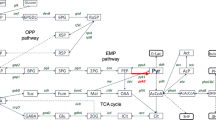Abstract.
Sucrose synthase (SS), a key enzyme in plant carbohydrate metabolism, has recently been isolated from Anabaena sp. strain PCC 7119, and biochemically characterized; two forms (SS-I and SS-II) were detected (Porchia et al. 1999, Planta 210: 34–40). The present study describes the first isolation and characterization of a prokaryotic SS gene, susA, encoding SS-II from that strain of Anabaena. A 7 kbp DNA fragment containing an open reading frame (EMBL accession number AJ010639) with about 30–40% amino acid identity with plant SSs was isolated from an Anabaena subgenomic library. The putative SS gene was demonstrated to encode an SS protein by expression in Escherichia coli. The biochemical properties of the recombinant enzyme were identical to those of the enzyme purified from the cyanobacterial cells. The deduced amino acid sequence of the Anabaena SS diverged from every plant SS reported. The occurrence of SS in cyanobacteria of different taxonomic groups was investigated. The enzyme occurs in several filamentous nitrogen-fixing cyanobacteria but not in two species of unicellular, non-diazotrophic cyanobacteria.
Similar content being viewed by others
Author information
Authors and Affiliations
Additional information
Received: 5 January 2000 / Accepted: 7 March 2000
Rights and permissions
About this article
Cite this article
Curatti, L., Porchia, A., Herrera-Estrella, L. et al. A prokaryotic sucrose synthase gene (susA) isolated from a filamentous nitrogen-fixing cyanobacterium encodes a protein similar to those of plants. Planta 211, 729–735 (2000). https://doi.org/10.1007/s004250000343
Issue Date:
DOI: https://doi.org/10.1007/s004250000343




